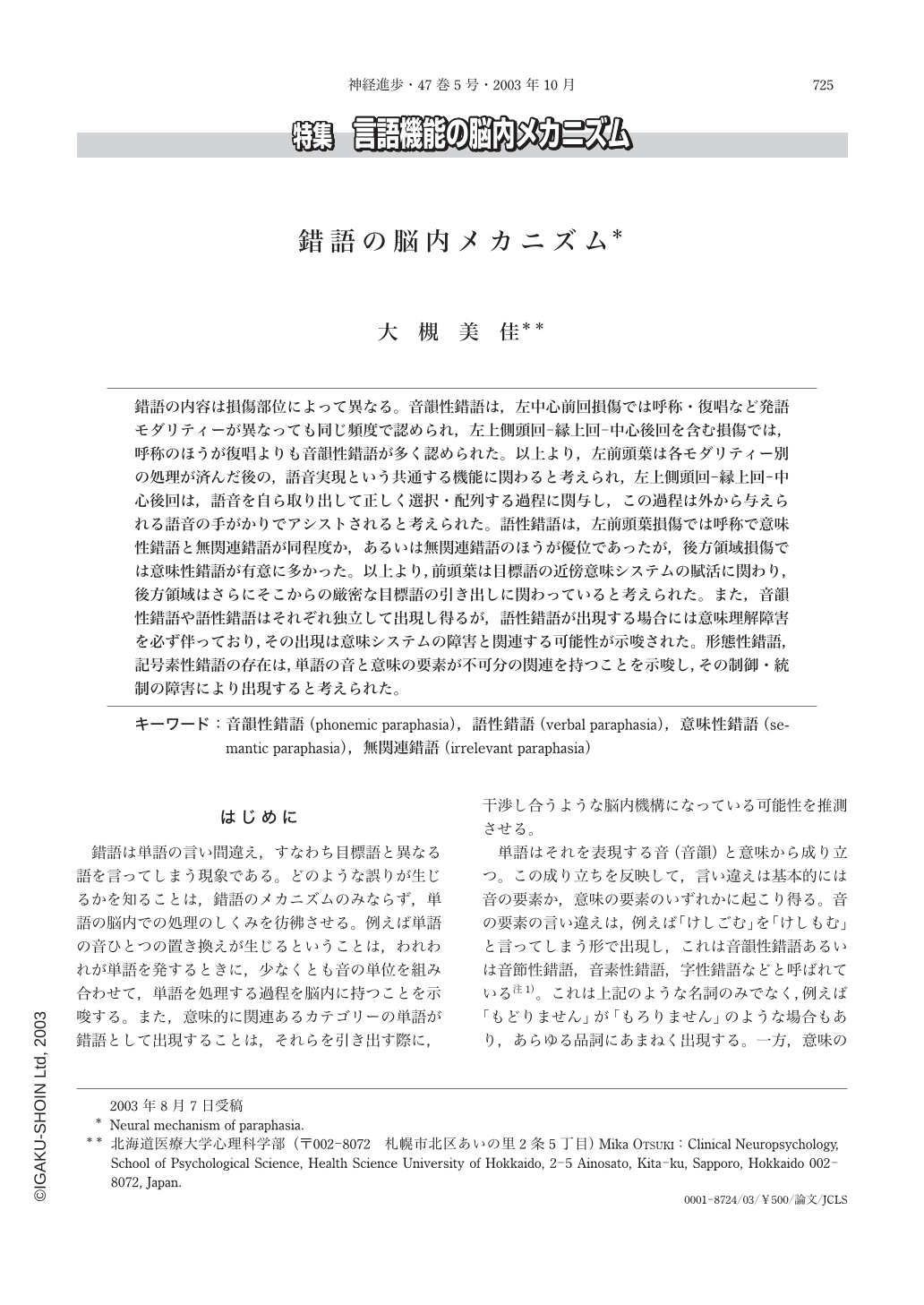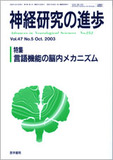Japanese
English
- 有料閲覧
- Abstract 文献概要
- 1ページ目 Look Inside
錯語の内容は損傷部位によって異なる。音韻性錯語は,左中心前回損傷では呼称・復唱など発語モダリティーが異なっても同じ頻度で認められ,左上側頭回-縁上回-中心後回を含む損傷では,呼称のほうが復唱よりも音韻性錯語が多く認められた。以上より,左前頭葉は各モダリティー別の処理が済んだ後の,語音実現という共通する機能に関わると考えられ,左上側頭回-縁上回-中心後回は,語音を自ら取り出して正しく選択・配列する過程に関与し,この過程は外から与えられる語音の手がかりでアシストされると考えられた。語性錯語は,左前頭葉損傷では呼称で意味性錯語と無関連錯語が同程度か,あるいは無関連錯語のほうが優位であったが,後方領域損傷では意味性錯語が有意に多かった。以上より,前頭葉は目標語の近傍意味システムの賦活に関わり,後方領域はさらにそこからの厳密な目標語の引き出しに関わっていると考えられた。また,音韻性錯語や語性錯語はそれぞれ独立して出現し得るが,語性錯語が出現する場合には意味理解障害を必ず伴っており,その出現は意味システムの障害と関連する可能性が示唆された。形態性錯語,記号素性錯語の存在は,単語の音と意味の要素が不可分の関連を持つことを示唆し,その制御・統制の障害により出現すると考えられた。
はじめに
錯語は単語の言い間違え,すなわち目標語と異なる語を言ってしまう現象である。どのような誤りが生じるかを知ることは,錯語のメカニズムのみならず,単語の脳内での処理のしくみを彷彿させる。例えば単語の音ひとつの置き換えが生じるということは,われわれが単語を発するときに,少なくとも音の単位を組み合わせて,単語を処理する過程を脳内に持つことを示唆する。また,意味的に関連あるカテゴリーの単語が錯語として出現することは,それらを引き出す際に,干渉し合うような脳内機構になっている可能性を推測させる。
単語はそれを表現する音(音韻)と意味から成り立つ。この成り立ちを反映して,言い違えは基本的には音の要素か,意味の要素のいずれかに起こり得る。音の要素の言い違えは,例えば「けしごむ」を「けしもむ」と言ってしまう形で出現し,これは音韻性錯語あるいは音節性錯語,音素性錯語,字性錯語などと呼ばれている注1)。これは上記のような名詞のみでなく,例えば「もどりません」が「もろりません」のような場合もあり,あらゆる品詞にあまねく出現する。一方,意味の要素の言い違えは,例えば「犬」を「猫」と言ってしまう形で出現し,語性錯語と呼ばれている。語性錯語はさらに大きく二つに分類され,全く無関連な語へ言い違える場合(例えば「犬」を「りんご」というような言い違え)は無関連錯語と呼ばれ,意味的に関連あるカテゴリーの単語と言い違える場合(例えば「犬」を「猫」というような言い違え)は意味性錯語と呼ばれている。そして,この音の入れ違え(音韻性錯語)と語の入れ違え(語性錯語)は,それぞれ異なる神経基盤をもつ症候群で生じる。すなわち,伝導失語と呼ばれる失語症候群では,錯語に関しては音韻性錯語のみが出現し,超皮質性感覚失語と呼ばれる失語症候群では,錯語に関しては語性錯語のみが出現する。前者は左側頭葉-頭頂葉の損傷で出現し,後者は左側頭-後頭葉,または前頭葉の損傷で出現する。これは二重解離注2)を示しているといえ,単語を形成する音と意味の両者の要素は,独立した機能によって音韻性錯語,ないし語性錯語を出現させているといえる。音韻性錯語と語性錯語は,このように単語の音と意味の要素を端的に表している明確な錯語であるが,そのいずれにも入りきらない錯語もあり,今後の解明が待たれるものもある。
本稿では,現時点まで明らかになっている音韻性錯語と語性錯語の出現に関与する神経基盤,錯語の誤り内容から推測される脳内機構を概説し,さらに未解決の他の錯語についても言及する。
The character of paraphasia depends on the localization of the lesion. With respect to the frequency of phonemic paraphasia, it does not depend on output modality such as naming and repetition when the lesion is located in the left precentral gyrus. While, phonemic paraphasia is caused more frequently on naming than on repetition when the lesion includes the part of the series of the left superior temporal gyrus-the supramarginal gyrus-the postcentral gyrus. We inferred that the left frontal lobe is involved in the final process to realize proper phonemes of the target word after the process performed depending on modality. While, the series of the left superior temporal gyrus-the supramarginal gyrus-the postcentral gyrus is involved in the process to select and arrange the phonemes of the target word, and this process can be assisted by the phonemes given on repetition task. Regarding verbal paraphasia, the left frontal lesion causes equal or more frequency of irrelevant paraphasia than semantic paraphasia, while the posterior lesion causes more semantic paraphasia than irrelevant paraphasia. This result indicates that the frontal lobe is involved in activation of the vicinity of the semantic system of the target word, and the posterior region is involved in strict selection of the target word. Both phonemic paraphasia and verbal paraphasia appear individually, however verbal paraphasia is always entails comprehension disturbance. It elucidates that verbal paraphasia may be implicated in the semantic system. The properties of morphological paraphasia and monemic paraphasia indicate that the phonemes and the semantics are indivisibly related each other, and the disturbance of the control of these elements may cause morphological paraphasia and monemic paraphasia.

Copyright © 2003, Igaku-Shoin Ltd. All rights reserved.


